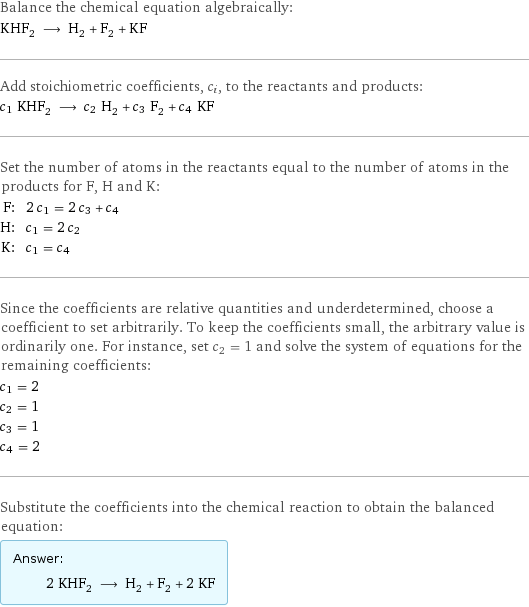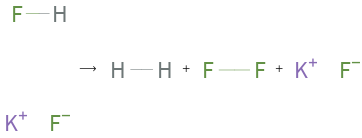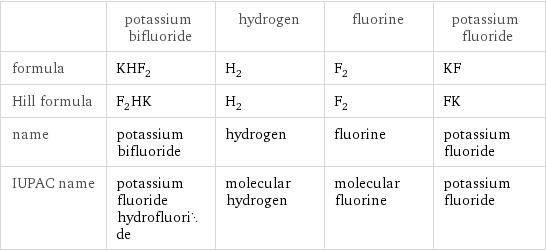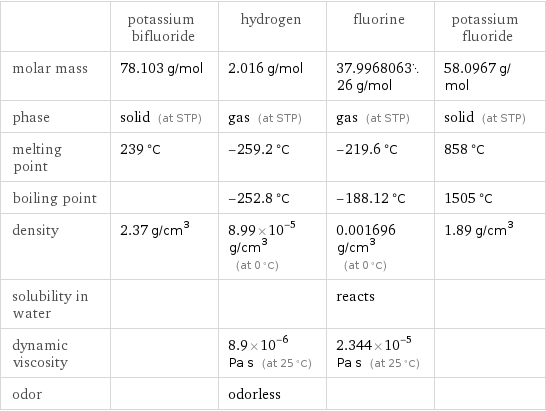Input interpretation

KHF_2 potassium bifluoride ⟶ H_2 hydrogen + F_2 fluorine + KF potassium fluoride
Balanced equation

Balance the chemical equation algebraically: KHF_2 ⟶ H_2 + F_2 + KF Add stoichiometric coefficients, c_i, to the reactants and products: c_1 KHF_2 ⟶ c_2 H_2 + c_3 F_2 + c_4 KF Set the number of atoms in the reactants equal to the number of atoms in the products for F, H and K: F: | 2 c_1 = 2 c_3 + c_4 H: | c_1 = 2 c_2 K: | c_1 = c_4 Since the coefficients are relative quantities and underdetermined, choose a coefficient to set arbitrarily. To keep the coefficients small, the arbitrary value is ordinarily one. For instance, set c_2 = 1 and solve the system of equations for the remaining coefficients: c_1 = 2 c_2 = 1 c_3 = 1 c_4 = 2 Substitute the coefficients into the chemical reaction to obtain the balanced equation: Answer: | | 2 KHF_2 ⟶ H_2 + F_2 + 2 KF
Structures

⟶ + +
Names

potassium bifluoride ⟶ hydrogen + fluorine + potassium fluoride
Equilibrium constant
![Construct the equilibrium constant, K, expression for: KHF_2 ⟶ H_2 + F_2 + KF Plan: • Balance the chemical equation. • Determine the stoichiometric numbers. • Assemble the activity expression for each chemical species. • Use the activity expressions to build the equilibrium constant expression. Write the balanced chemical equation: 2 KHF_2 ⟶ H_2 + F_2 + 2 KF Assign stoichiometric numbers, ν_i, using the stoichiometric coefficients, c_i, from the balanced chemical equation in the following manner: ν_i = -c_i for reactants and ν_i = c_i for products: chemical species | c_i | ν_i KHF_2 | 2 | -2 H_2 | 1 | 1 F_2 | 1 | 1 KF | 2 | 2 Assemble the activity expressions accounting for the state of matter and ν_i: chemical species | c_i | ν_i | activity expression KHF_2 | 2 | -2 | ([KHF2])^(-2) H_2 | 1 | 1 | [H2] F_2 | 1 | 1 | [F2] KF | 2 | 2 | ([KF])^2 The equilibrium constant symbol in the concentration basis is: K_c Mulitply the activity expressions to arrive at the K_c expression: Answer: | | K_c = ([KHF2])^(-2) [H2] [F2] ([KF])^2 = ([H2] [F2] ([KF])^2)/([KHF2])^2](../image_source/a6f2385f58e25e424e1229f7b2a5a969.png)
Construct the equilibrium constant, K, expression for: KHF_2 ⟶ H_2 + F_2 + KF Plan: • Balance the chemical equation. • Determine the stoichiometric numbers. • Assemble the activity expression for each chemical species. • Use the activity expressions to build the equilibrium constant expression. Write the balanced chemical equation: 2 KHF_2 ⟶ H_2 + F_2 + 2 KF Assign stoichiometric numbers, ν_i, using the stoichiometric coefficients, c_i, from the balanced chemical equation in the following manner: ν_i = -c_i for reactants and ν_i = c_i for products: chemical species | c_i | ν_i KHF_2 | 2 | -2 H_2 | 1 | 1 F_2 | 1 | 1 KF | 2 | 2 Assemble the activity expressions accounting for the state of matter and ν_i: chemical species | c_i | ν_i | activity expression KHF_2 | 2 | -2 | ([KHF2])^(-2) H_2 | 1 | 1 | [H2] F_2 | 1 | 1 | [F2] KF | 2 | 2 | ([KF])^2 The equilibrium constant symbol in the concentration basis is: K_c Mulitply the activity expressions to arrive at the K_c expression: Answer: | | K_c = ([KHF2])^(-2) [H2] [F2] ([KF])^2 = ([H2] [F2] ([KF])^2)/([KHF2])^2
Rate of reaction
![Construct the rate of reaction expression for: KHF_2 ⟶ H_2 + F_2 + KF Plan: • Balance the chemical equation. • Determine the stoichiometric numbers. • Assemble the rate term for each chemical species. • Write the rate of reaction expression. Write the balanced chemical equation: 2 KHF_2 ⟶ H_2 + F_2 + 2 KF Assign stoichiometric numbers, ν_i, using the stoichiometric coefficients, c_i, from the balanced chemical equation in the following manner: ν_i = -c_i for reactants and ν_i = c_i for products: chemical species | c_i | ν_i KHF_2 | 2 | -2 H_2 | 1 | 1 F_2 | 1 | 1 KF | 2 | 2 The rate term for each chemical species, B_i, is 1/ν_i(Δ[B_i])/(Δt) where [B_i] is the amount concentration and t is time: chemical species | c_i | ν_i | rate term KHF_2 | 2 | -2 | -1/2 (Δ[KHF2])/(Δt) H_2 | 1 | 1 | (Δ[H2])/(Δt) F_2 | 1 | 1 | (Δ[F2])/(Δt) KF | 2 | 2 | 1/2 (Δ[KF])/(Δt) (for infinitesimal rate of change, replace Δ with d) Set the rate terms equal to each other to arrive at the rate expression: Answer: | | rate = -1/2 (Δ[KHF2])/(Δt) = (Δ[H2])/(Δt) = (Δ[F2])/(Δt) = 1/2 (Δ[KF])/(Δt) (assuming constant volume and no accumulation of intermediates or side products)](../image_source/148d78e96941aac875175ecb4f7dae99.png)
Construct the rate of reaction expression for: KHF_2 ⟶ H_2 + F_2 + KF Plan: • Balance the chemical equation. • Determine the stoichiometric numbers. • Assemble the rate term for each chemical species. • Write the rate of reaction expression. Write the balanced chemical equation: 2 KHF_2 ⟶ H_2 + F_2 + 2 KF Assign stoichiometric numbers, ν_i, using the stoichiometric coefficients, c_i, from the balanced chemical equation in the following manner: ν_i = -c_i for reactants and ν_i = c_i for products: chemical species | c_i | ν_i KHF_2 | 2 | -2 H_2 | 1 | 1 F_2 | 1 | 1 KF | 2 | 2 The rate term for each chemical species, B_i, is 1/ν_i(Δ[B_i])/(Δt) where [B_i] is the amount concentration and t is time: chemical species | c_i | ν_i | rate term KHF_2 | 2 | -2 | -1/2 (Δ[KHF2])/(Δt) H_2 | 1 | 1 | (Δ[H2])/(Δt) F_2 | 1 | 1 | (Δ[F2])/(Δt) KF | 2 | 2 | 1/2 (Δ[KF])/(Δt) (for infinitesimal rate of change, replace Δ with d) Set the rate terms equal to each other to arrive at the rate expression: Answer: | | rate = -1/2 (Δ[KHF2])/(Δt) = (Δ[H2])/(Δt) = (Δ[F2])/(Δt) = 1/2 (Δ[KF])/(Δt) (assuming constant volume and no accumulation of intermediates or side products)
Chemical names and formulas

| potassium bifluoride | hydrogen | fluorine | potassium fluoride formula | KHF_2 | H_2 | F_2 | KF Hill formula | F_2HK | H_2 | F_2 | FK name | potassium bifluoride | hydrogen | fluorine | potassium fluoride IUPAC name | potassium fluoride hydrofluoride | molecular hydrogen | molecular fluorine | potassium fluoride
Substance properties

| potassium bifluoride | hydrogen | fluorine | potassium fluoride molar mass | 78.103 g/mol | 2.016 g/mol | 37.996806326 g/mol | 58.0967 g/mol phase | solid (at STP) | gas (at STP) | gas (at STP) | solid (at STP) melting point | 239 °C | -259.2 °C | -219.6 °C | 858 °C boiling point | | -252.8 °C | -188.12 °C | 1505 °C density | 2.37 g/cm^3 | 8.99×10^-5 g/cm^3 (at 0 °C) | 0.001696 g/cm^3 (at 0 °C) | 1.89 g/cm^3 solubility in water | | | reacts | dynamic viscosity | | 8.9×10^-6 Pa s (at 25 °C) | 2.344×10^-5 Pa s (at 25 °C) | odor | | odorless | |
Units
